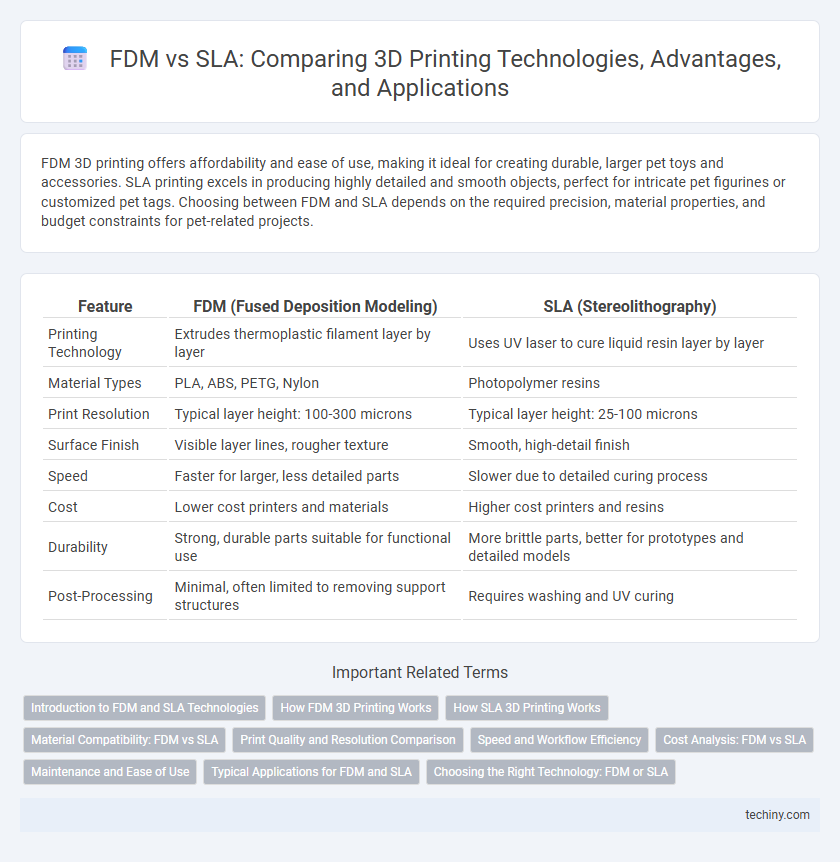FDM 3D printing offers affordability and ease of use, making it ideal for creating durable, larger pet toys and accessories. SLA printing excels in producing highly detailed and smooth objects, perfect for intricate pet figurines or customized pet tags. Choosing between FDM and SLA depends on the required precision, material properties, and budget constraints for pet-related projects.
Table of Comparison
| Feature | FDM (Fused Deposition Modeling) | SLA (Stereolithography) |
|---|---|---|
| Printing Technology | Extrudes thermoplastic filament layer by layer | Uses UV laser to cure liquid resin layer by layer |
| Material Types | PLA, ABS, PETG, Nylon | Photopolymer resins |
| Print Resolution | Typical layer height: 100-300 microns | Typical layer height: 25-100 microns |
| Surface Finish | Visible layer lines, rougher texture | Smooth, high-detail finish |
| Speed | Faster for larger, less detailed parts | Slower due to detailed curing process |
| Cost | Lower cost printers and materials | Higher cost printers and resins |
| Durability | Strong, durable parts suitable for functional use | More brittle parts, better for prototypes and detailed models |
| Post-Processing | Minimal, often limited to removing support structures | Requires washing and UV curing |
Introduction to FDM and SLA Technologies
Fused Deposition Modeling (FDM) utilizes thermoplastic filaments melted and extruded layer by layer to build durable prototypes and functional parts, offering cost-effective and user-friendly 3D printing. Stereolithography (SLA) employs a laser to cure liquid resin into precise, highly detailed objects, excelling in producing smooth surface finishes and intricate geometries. Both technologies serve distinct applications, with FDM favored for rapid prototyping and mechanical components, while SLA is preferred for fine details and high-resolution models.
How FDM 3D Printing Works
FDM 3D printing operates by extruding thermoplastic filament through a heated nozzle, layer by layer, to build objects from the bottom up. The filament is precisely melted and deposited onto the build platform, solidifying quickly to form each successive layer with dimensional accuracy. This technique enables cost-effective production and is widely used for prototyping and functional parts due to its material versatility and ease of use.
How SLA 3D Printing Works
SLA 3D printing utilizes a UV laser to selectively cure liquid photopolymer resin layer by layer, achieving high precision and smooth surface finishes. The process begins by lowering a build platform into a resin tank, where the laser traces each cross-section of the model, solidifying the resin immediately. This method offers superior detail and accuracy compared to FDM, making it ideal for intricate prototypes and fine-featured parts.
Material Compatibility: FDM vs SLA
Fused Deposition Modeling (FDM) primarily utilizes thermoplastic filaments such as PLA, ABS, and PETG, offering broad material compatibility suited for functional prototypes and end-use parts. Stereolithography (SLA) employs photopolymer resins, enabling high-resolution prints with fine details but typically limited to specialized resin types like standard, tough, flexible, and castable resins. The choice between FDM and SLA depends on the required mechanical properties and surface finish, with FDM supporting durable, heat-resistant materials and SLA excelling in producing intricate, smooth models from versatile resin formulations.
Print Quality and Resolution Comparison
FDM printers typically offer layer resolutions between 50 to 300 microns, resulting in visible layer lines and lower surface detail compared to SLA. SLA technology uses a laser to cure resin with a resolution often as fine as 25 microns, producing smoother surfaces and intricate details ideal for high-precision models. The superior print quality and higher resolution of SLA make it the preferred choice for applications demanding fine features and detailed prototypes.
Speed and Workflow Efficiency
FDM printers generally offer faster print speeds, making them ideal for rapid prototyping and iterative design processes. SLA technology excels in producing highly detailed and smooth surface finishes but usually requires longer print times and post-processing steps, impacting overall workflow efficiency. Choosing between FDM and SLA depends on balancing speed requirements with the desired precision and quality of the final product.
Cost Analysis: FDM vs SLA
FDM 3D printing offers lower material and equipment costs, making it more budget-friendly for prototyping and low-volume production. SLA printing demands higher initial investment due to expensive resins and maintenance but yields superior resolution and surface finish, justifying costs in detail-oriented applications. Cost analysis reveals FDM benefits small-scale projects, while SLA suits high-precision needs despite greater expenses.
Maintenance and Ease of Use
FDM printers require regular nozzle cleaning and filament replacement, making maintenance straightforward but frequent. SLA printers involve more complex upkeep, including resin handling, tank cleaning, and post-curing processes that demand careful attention. FDM offers easier setup and user-friendly operation, while SLA provides higher precision at the cost of more intricate maintenance routines.
Typical Applications for FDM and SLA
Fused Deposition Modeling (FDM) is commonly used for prototyping functional parts, manufacturing jigs, fixtures, and end-use components due to its affordability and material versatility, including thermoplastics like ABS and PLA. Stereolithography (SLA) excels in producing highly detailed and smooth surface finish models, often applied in dental molds, jewelry, and intricate engineering prototypes where precision and fine features are critical. Both technologies serve distinct roles across industries such as automotive, aerospace, and healthcare, driven by their unique material properties and resolution capabilities.
Choosing the Right Technology: FDM or SLA
Choosing between FDM and SLA for 3D printing depends on the desired application and precision requirements. FDM excels in producing durable prototypes and functional parts with affordable material costs, making it ideal for rapid prototyping and larger models. SLA offers superior surface finish and intricate detail accuracy, suitable for applications like jewelry, dental models, and highly detailed miniatures.
FDM vs SLA Infographic

 techiny.com
techiny.com